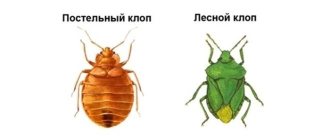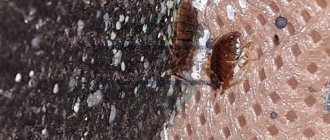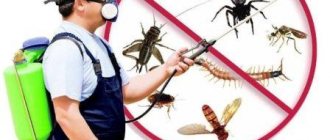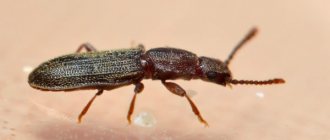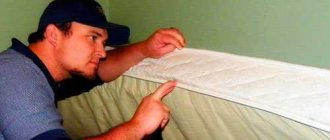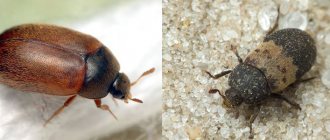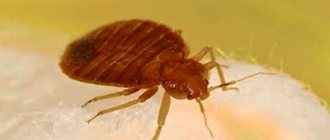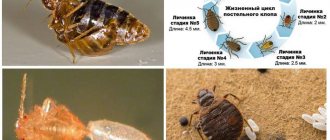- By Vil Malinoshevsky
- About bedbugs
Very often in our work we come across people who were sure (or wanted to believe) that there are means that bedbugs are afraid of and with which these parasites can be scared away from the apartment. Such products are the dream of many, because if they really effectively repelled bedbugs, then with their help it would be possible to get rid of parasites without the need to treat the apartment with chemicals, which many are afraid of.
Bed bugs in an open shelter, from which it is almost impossible to drive them out ©Mario David Bazan
It is very significant that all these people sooner or later turn to pest control services to poison bedbugs. That is, it is obvious that they failed to scare away the bedbugs and had to use really effective measures.
We always ask our clients what means they used to poison bedbugs before contacting us. We need this, at a minimum, in order to select a drug with an active substance that has not been used before in a particular apartment. And although many people do not admit that they have tried to repel bedbugs, many report that they have used various herbs, ultrasonic repellers, essential oils and the like.
Approximately half of our customers told us that they had dabbled in such supposedly “repellent” products. If not the entire remaining half, then a significant part also probably did this, but they didn’t admit it to us.
Let's now find out what bedbugs are really afraid of, what they are not afraid of, and whether they can be removed with some repellents.
Will bedbugs go away if you use the products they are afraid of?
Let's start with the main thing: bed bugs cannot be scared away from the apartment . Even though there are things that bedbugs are truly afraid of, there are no ways to apply these things in a way that will drive bedbugs away. Practice shows (and theory proves this) that you can either kill bedbugs indoors or continue to feed them with your blood.
The video below shows treatment in an apartment, in which they tried to repel bedbugs first with tansy and then with essential oils:
We do not know of a single case where people, after the fact of infestation of an apartment, managed to scare bedbugs out of it. We have encountered situations that seemed similar to this, but most likely it was not a matter of scaring.
For example, there was a case when a person caught a bedbug on his bed, crushed it, sprinkled vinegar in the corners and never saw any more bedbugs at home. The man believes that it was with vinegar that he was able to repel bedbugs. We believe that in this situation, a person brought home one bedbug on his clothes or in a bag, by a lucky chance he saw this one bedbug, killed it, and the vinegar no longer affected anyone, simply because there was not a single living bedbug left in the room. That is, in this case, there was no fact of infection of the apartment: bedbugs did not begin to multiply here.
If the bugs in the apartment have clearly begun to multiply, it is impossible to scare them all away, but not destroy them.
Are they afraid or not?
And now about what bedbugs are not afraid of. The use of all the senseless methods listed below will only aggravate the situation, helping to increase the population of bloodsuckers many times over. Despite the control methods advertised on the Internet, insects are completely indifferent to:
- Ultrasonic and magnetic resonance repellers. Despite the assurances of the manufacturers of these structures, which guarantee the expulsion of almost all synanthropic and flying insects, neither ultrasound nor the electromagnetic field has any effect on household pests. There are many cases where, in practice, bloodsuckers successfully explored an ultrasonic repeller without reacting at all to the high-frequency vibrations it emitted. Therefore, it makes no sense to purchase this kind of structure for this purpose.
- Saline solution. To prepare it, mix a few tablespoons of salt with water, and the resulting mixture is recommended to be used to treat pest habitats. However, wet cleaning of infected surfaces using this composition will not help remove bedbugs at all.
- Mixtures of vanillin and soda. Although the combination of these ingredients will smell pleasant, bed parasites are not afraid of this smell. Many people were able to verify in practice that the composition of vanilla and soda is not capable of working miracles.
- Garlic is another useless remedy for bed bugs.
- Alabaster. To poison bed bloodsuckers with it, the powder must penetrate the insects’ body, which is impossible to achieve.
- Conspiracies. Despite the fact that this method of combating parasites is still used in deep provinces, it is completely useless.
By knowing what bed bugs are most afraid of, you can prevent the next appearance of these harmful insects.
Why is it impossible to scare bedbugs out of an apartment?
There are several reasons for the fundamental impossibility of driving bedbugs out of an apartment. The first of them: bedbugs have nowhere to go. They do not know that they can leave this room to join their neighbors, because most of them do not move such distances in their entire lives.
There are times when they can crawl along the heating riser every night from the apartment above to you, and crawl back there the next morning. However, this is rare, and most bedbugs only know the route from their daytime hiding place to and from their bed. If something appears in the apartment that they are afraid of, they will prefer to simply endure it in shelters, and then, when they are very hungry, they will crawl out, despite the unpleasant smell for them.
Sometimes people get the false impression that if bedbugs are poisoned by neighbors, then the insects are afraid of the product and run to neighboring apartments. In fact, when baited with chemical insecticides, bedbugs do not run anywhere. They can crawl out of their shelters, they can die in these shelters, but, in fact, they cannot escape from the room.
Indeed, migration occurs when people systematically open up bedbug hiding places. Insects try to hide in new dark secluded places, people open them up too, insects crawl into new shelters and some of them end up in cracks in the walls, in sockets and electrical wiring grooves, in ventilation, and these are passages into neighbors’ apartments. Of these, this part of the bedbugs gets into the neighbors.
But such a situation is possible when neighbors either very carefully open up all the nests of bedbugs, which rarely happens (more often people are lazy and don’t do this), or when neighbors make repairs and strip all the walls, floors, and ceilings down to concrete, that is, they simply deprive bedbugs of shelter . Bedbugs, accordingly, can only hide in the paths that lead to your home, and along these paths they enter your apartment. It looks like they are "running" out of fear, but in reality they are just doing what they have been doing all along - hiding in the safest places.
If bedbugs still have places to hide specifically in your apartment, you won’t be able to drive these parasites away with any repellents. If they are afraid of something, they will simply hide in these places. This will not make things any easier for homeowners.
The second reason: bedbugs quickly adapt to many repellents, even if they were initially afraid of such drugs. This is very clearly seen in practice: if you place a wormwood branch under an uninfected bed, then for a day or two the parasites will not climb onto this bed. But then, one or two at a time, they will begin to get out from behind the baseboards, go around this wormwood and climb onto the bed, and when each individual repeats this two or three times, it will stop paying attention to this remedy. This will already happen for the third reason: hunger is stronger than fear.
This rule works throughout the animal world, and in humans too. For a day or two, while the bugs are not hungry, they may not bite if they are afraid of some kind of remedy. When they are really hungry, they will be able to overcome their fear in order to find food.
It is well known that very hungry bedbugs can get out and bite even in the light, although in general they are more afraid of light than most other environmental factors. And if they can bite in the light, then they will also bite if they smell bleach, tansy or some kind of essential oil.
And the fourth reason: not all products that are considered to repel bedbugs actually repel them. There are clear dummies, for example, ultrasonic or electromagnetic repellers. There are products that bedbugs are afraid of, but to which they get used. There are tools whose operating principles people do not fully understand.
For example, the same vinegar: if it gets on a bug, it kills it. But if you simply sprinkle furniture and walls with vinegar, the smell will repel bedbugs for two to three days. After this, the parasites will get used to it and will calmly run around the baseboards that smell of vinegar. Moreover, the smell of vinegar will weaken over time.
Hence we conclude: bedbugs cannot be driven out of the apartment by any means. Even if they are afraid of certain smells, or, for example, light, then for a short time you can reduce the strength and frequency of their bites, but after a few days everything will return to its place.
Now let's go specifically through the most well-known means, phenomena and environmental factors that bedbugs are supposedly afraid of.
Cold and frost
Like any living creatures, bedbugs cannot tolerate too low temperatures and die when exposed to them. At temperatures below 9°C they stop reproducing, at any frost they fall into torpor, at a temperature of -17°C they die within a day. Therefore, if they start to get cold and have the opportunity to move to a warmer place, they will move there. If you try to freeze them out of the apartment, this will not happen, because the bedbugs living in sleeping places and in different shelters in the apartment simply do not know where to run to keep warm. They will go into torpor right in the shelters, and if the temperature here is too low, they will die.
Only some of the bugs that live on the border between warm and cold rooms will be able to move to where it is warmer. These insects are relatively few in number.
Simply put, if you try to influence bedbugs with cold, constantly ventilate the apartment and lower the temperature here even to 0°C at night or for the day, this will not work. The bugs will safely survive such cooling and will bite again after it is complete. Those bugs that live in the sofa, behind the baseboards and behind the furniture will not go anywhere and will not die from such cold. If you try to lower the room temperature to -17 - -20°C for a couple of days, your radiators and water pipes will burst. You will have to make repairs, and this is more difficult than eliminating bedbugs.
Light
Bed bugs are really afraid of light and normally do not bite either in the light of the sun or in artificial light. But if you simply do not turn off the lights in the room at night, then on the third or fourth day the bugs will begin to crawl out and bite people in the light. This has been verified.
We filmed those videos where our volunteers were bitten by bedbugs in the evening in the light, and the parasites bit safely, sucked blood and did not think of running away somewhere:
And many people tell us that after a long absence indoors they were bitten even in daylight. That is, bedbugs are afraid of light, but only when they are full and happy, and they are definitely not afraid of it enough to leave a constantly lit room.
Household chemicals with a strong odor
These means include:
- Chlorine and other chlorine compounds
- White
- Vinegar
- Kerosene
- Ammonia or regular alcohol
- Ammonia
- Acetone
- Vinegar essence
...and the like. All these are caustic substances with a strong odor. It is believed that it is their smell that bedbugs are afraid of. This is partly true: as soon as such a smell appears in a room, bedbugs prefer to sit out in shelters. But only until they get very hungry. When they are hungry, they will crawl out, despite the smell of bleach or kerosene, and crawl to bite people along the walls on which these substances have dried.
Such products do not have a residual effect after drying and will not kill bedbugs crawling on dried surfaces.
If the same vinegar or bleach gets directly on the bug, the insect will die. Therefore, in principle, found nests can be treated with such means, although modern insecticides are much more effective, but they do not stink so much, do not leave marks and do not create a fire risk. But if you open all the bedbug nests, you can destroy them all at once and you will no longer have to scare them away.
On a note
But boric acid, which is quite effective against cockroaches, does not kill bedbugs. In order to be poisoned by it, an insect must eat it, but bedbugs are not capable of this.
Laundry and tar soap, as well as tar, are completely useless against bedbugs. They do not scare bedbugs with their smell, nor can they kill parasites with their action. The same is true for vanillin and fish oil (I wonder why anyone would think that fish oil could repel bedbugs?).
Someone is trying to repel bedbugs with hydrogen peroxide. In fact, due to the lack of odor, bedbugs do not pay attention to it at all, but if it is poured directly on them, they will die quickly enough.
And one more dangerous thing is naphthalene. Bedbugs are not afraid of it, but they die from contact with it. But it is also presumably a carcinogen and its presence in a residential area is much more dangerous than the presence of bed bugs.
Classification of methods for combating
There are several ways to get rid of unpleasant insects. One of the most important requirements is the use of an integrated approach.
Best methods:
- physical-mechanical,
- chemical,
- folk
The combination of these methods is due to the fact that “chemistry” harms humans, animals and plants. Traditional recipes are not always effective.
Physico-mechanical technique
Not everyone can catch bedbugs with their hands and kill them. These insects not only have a repulsive appearance, but also a disgusting smell.
Mechanical action involves the use of a steam iron. It is used when treating the most “bedbug-infested” areas of linen – seams and folds.
It is advisable to treat not only linen, but also furniture, as well as the gap between the bed and mattress.
Important! You should not use boiling water to flood insect nesting sites.
They are very afraid of boiling water, but furniture does not react to it in the best way.
Liquid nitrogen helps a lot. A spray bottle is filled with this product. You can also use a pneumatic spray - this way the cryogen will get even into hard-to-reach places.
Use of special drugs
The table provides information about the most powerful drugs.
| Means | Description | Price |
| "Chlorophos" | The most powerful insecticide. Intended for storage in non-residential premises. It is very important to store it in a tightly sealed container. The proportions with water are 1 to 4. The solution is prepared outside or with the windows open. | 1000 rubles/1 kg. |
| "Karbofos" | Has an unpleasant pungent odor. After spraying it disappears very quickly. Has a wide range of effects. Has a long protective period. | Negotiable |
| "Mikrofos" | Long-term preservation, wide spectrum of action. Not only bedbugs die, but also cockroaches, ants, and fleas. Active ingredient: chlorpyrifos. Has no smell. It is safe to use, because has very low toxicity. Intended for professional processing. | Negotiable |
| "Pyrethrum" | Strong poison, fatal to all types of insects. | 150 rubles |
| "Tetrix" | The most effective drug. Not available for free sale. | , |
| "Combat" | “Multispray” is used (a fast-acting drug. It has a paralytic effect), as well as “Superspray”. The main advantage is low toxicity. The composition includes imiprotrin, cyphenothrin. The death of parasites is immediate. | From 200 rubles. |
| "Executioner" | Quickly destroys adults, as well as larvae and eggs. There is almost no smell and no stains remain. | From 180 |
Grandmother's funds
Chamomile has a powerful effect. Both fresh herbs and pharmaceutical preparations are used. Chamomile is brewed in boiling water, infused for 40 minutes, then carefully filtered and charged into a spray bottle. The prepared solution is used to treat all problem areas in the room. Its use will help expel bloodsuckers and prevent their return. Chamomile does not affect eggs. When a new population appears, new treatments will be required.
Another remedy is table vinegar. They need to wipe all places where parasites accumulate. Care must be taken as vinegar is quite aggressive. Due to its impact, not only bedbugs can suffer, but also some surfaces.
It is believed that cockroaches eat bedbug eggs. This is true, but this happens quite rarely.
Important! The diet of cockroaches and bedbugs is not the same.
Cockroaches feed on food scraps, bedbugs feed on human blood. This allows both species to exist peacefully in the same territory. This makes the life of an apartment owner significantly more difficult.
After removing bedbugs, it is necessary to carry out general cleaning. If a strong insecticide was used, the room should be well ventilated. Dead insects must be carefully collected and burned.
Wet cleaning should be done using cleaning products. The floors are washed with soapy water or powder several times.
You also need to “arm yourself” with a vacuum cleaner and carefully “walk” through all the upholstered furniture, carpets and bookshelves. It’s good if the vacuum cleaner also has a cleaning effect.
Smells of plants
According to our statistics, this is the favorite pastime of those who have not yet been bitten by bedbugs too much - trying to scare them away with odors. As a group, we compiled a list of such means when we remembered what people tried to scare bedbugs with:
- Sagebrush
- Black cohosh
- Garlic
- Lavender
- Mint
- Mustard
- Valerian
- Tobacco
- Chamomile
- Eucalyptus
- Geranium
- Needles
- Birch buds and birch bark
- Orange
- Bay leaf
- Fern
It’s unclear what fern or birch bark has to do with it, because they have practically no smell. But the smell of geranium can drive people out of an apartment, but not bedbugs, although for some it is a normal houseplant.
Many people get headaches from the smell of geranium.
In general, all these herbs are countless - if the grass has a smell, someone will certainly try to scare away bedbugs with it. But we have already talked about the result: no one has ever succeeded in scaring off bedbugs for good with at least some of these herbs individually, even though with a whole bouquet of them. We don't know of such cases. I think if such grass had been found that could drive bedbugs out of an apartment, we would have lost our jobs a long time ago.
Warming things up in the sun
Bed bugs hate heat and the ultraviolet range of the sun is the best.
In addition to blinding them, it also warms up the insides through the translucent shell of the body. So it makes sense to periodically warm up carpets, mattresses and other portable items in the open sunlight. This can be done even in winter, if the sun's rays linger here for some time.
Before such sunbathing, it is useful to thoroughly vacuum and pat down all things.
Essential oils
It's the same here as with herbs. Only if some herbs smell unpleasant, then people love essential oils, because they seem to fight bedbugs, and, it seems, there is a divine aroma in the apartment.
But you already understand that if a bug is faced with a question of life and death, either it crawls out and bites a person at the smell of some tea tree oil, or it is dying of hunger, it will crawl out and bite.
By the way, turpentine should be included in this same category - this is also an essential oil from different parts of coniferous trees. It just doesn’t smell as pleasant to humans as eucalyptus oil. But bedbugs don’t care; they react to turpentine the same way as to any other oil.
In the same category, Zvezdochka balm is a mixture of fat-based essential oils with the same inaction on bedbugs as pure aromatic oils.
Various perfumery products are completely similar to oils: perfumes, colognes, deodorants. To some extent, bedbugs will bite a heavily perfumed person less aggressively, partly because the smell of perfume will mask the smell of sweat and carbon dioxide, which bedbugs focus on when searching for a person. But perfumes cannot reliably protect against their bites.
Other insects
In addition to bedbugs, other insects may live in the apartment. Not all of them are able to live together. Some may eat other parasites. Bedbugs get along with cockroaches. They have different food and habitat. Only in some cases do cockroaches eat bedbug eggs.
The enemies of house bugs are:
- ants;
- centipedes;
- spiders;
- mites;
- other types of predatory bugs.
Iron steam and boiling water
To say that bedbugs are afraid of steam or boiling water would not be entirely correct. If steam or boiling water hits them, they die. If the sofa was treated with steam, but the bedbugs survived somewhere deep in the structure, then they will safely run around the place where the steam settled and cooled, and will not be afraid of it. That is, again, steam from an iron or steam generator can be destroyed by treating them directly, but it will not be possible to scare them away.
In the same way, bedbugs are not afraid of clean water, or, for example, water with salt or soda at all. That is, splashing salt water in the corners is useless.
In no way do I want to offend anyone’s feelings, but holy water from the church also does not scare or kill bedbugs. Boiling water is more effective for this. Even just warm water at a temperature of 50-55°C kills bedbugs in a few minutes. Therefore, they can be destroyed in linen and things when washed in a washing machine.
But bedbugs are not afraid of normal heat. 33-35 degrees is a completely tolerable temperature for them. They already do not tolerate temperatures above 40°C well, but they do not die yet, and begin to die out at 45°C. At the same time, the level of humidity has little effect on their condition even at high temperatures.
You have probably already noticed that we have listed almost all the traditional methods of fighting bedbugs. Alas, this is true: we have currently carried out more than 15,000 treatments for bedbugs and we have no reason to believe that any of these methods can reliably get rid of bedbugs. Perhaps such a method exists and we just haven’t communicated with the people it helped. Perhaps there are situations when, given a combination of circumstances, folk remedies and methods work. But we have not heard of such precedents.
